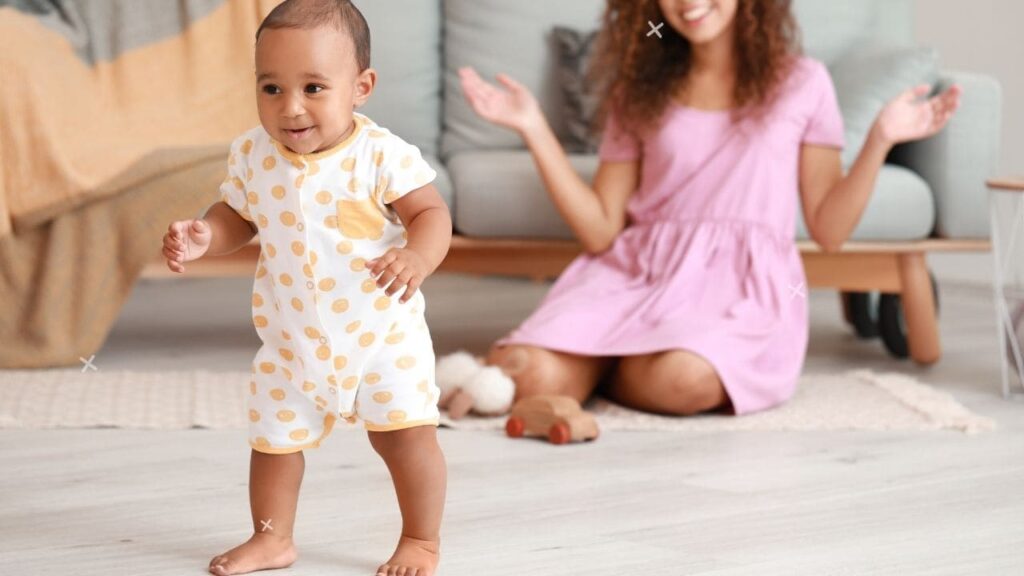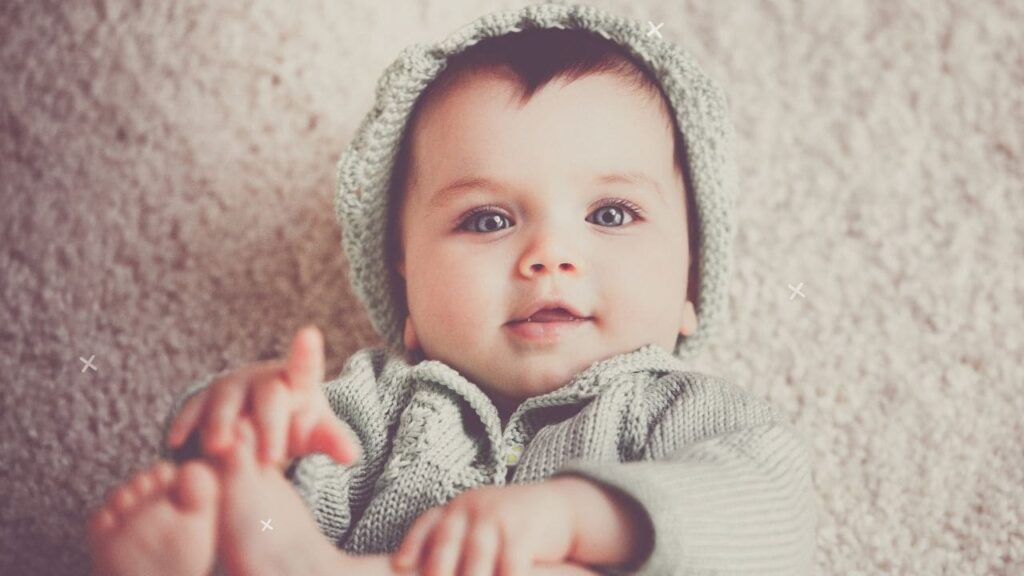As an expectant parent staring adoringly at those teeny newborn clothes, knowing when your little bundle of joy will outgrow them can be perplexing. I admit those miniature buttons and delicate fabrics that newborn sizes come in are impossible to resist!
When I was prepping for my daughter’s arrival, I wanted to stock up properly on newborn clothing without going overboard. But figuring out the newborn clothing timeline felt like a guessing game.
After doing some research and learning from experience, I uncovered the main factors impacting how long do babies wear newborn clothes. I’m sharing everything I learned so you can shop smarter during this magical and fleeting stage!
What Size Clothes Do Newborns Wear?
Newborn sizes typically cover babies from 0-3 months or up to 10 pounds. Many popular baby clothing brands size their newborn range for babies approximately 7-10 pounds.
So when you’re shopping for the earliest days, you’ll usually see baby clothing sizes listing:
- Newborn: Up to 10 lbs
- 0-3 months: 8-12 lbs
- 3-6 months: 12-16 lbs
I was surprised to discover that the weight ranges can vary quite a bit across brands and countries. For example, many European sizing charts list newborns going up to 3.5 kgs which is around 7.5 lbs. So do some comparisons across your favorite stores.
Stay tuned in towards the higher end of the newborn weight limit, as your baby approaches 10-11 lbs. The roomier 0-3 month or 3-6 month sizes will likely fit better soon.
Occasionally some smaller preemie babies born earlier skip over the newborn bracket altogether. But most healthy, full-term baby babies around 7-8 lbs fit nicely into newborn dimensions at the start.
Focusing on newborn clothing measurements over months
Rather than relying only on the “months” baby clothes sizing, pay close attention to weight limits and garment measurements. Those details matter more than the age labeling.
Babies grow rapidly, so a small newborn could outgrow something labeled “0-3 months” quickly if they hit the upper end of the weight or length limit earlier than expected. Check clothing items against your baby’s current measurements if the fit seems snug already.
To give you a better idea of the range of newborn clothing sizes across popular brands, check out this handy comparison table:
| Brand | Weight Limit | Length Limit |
|---|---|---|
| Carter’s | Up to 10 lbs | Up to 21″ long |
| Gerber | Between 5.5 – 9 lbs | Up to 21″ long |
| Old Navy | Up to 10 lbs | Up to 23″ long |
| GAP | Up to 11 lbs | Up to 23″ long |
| Disney | Between 7 – 10 lbs | Up to 22″ long |
| Cat & Jack | Up to 10 lbs | Up to 21″ long |
| Burt’s Bees Baby | Up to 10 lbs | 20-23″ long |
As you can see, while the newborn size typically covers around 7-11 pounds, there is some variation in maximum weight and length between popular brands. When shopping, check the specific dimensions against your baby’s current measurements for the best fit.
When Do Babies Outgrow Newborn Clothes?
Many first-time parents find their new babies outgrow those precious newborn clothes more rapidly than expected, sometimes in 4 short weeks! While the exact timing depends a lot on the birth weight and genetics of your specific baby, most start filling out somewhere around weeks 5-8 of the newborn clothes duration.
My daughter was born at a healthy 7 lbs 8 oz. By her 2 month check-up she was 12 lbs 1 oz – well into 0-3 month territory for clothing! Her growth rate surprised me with how quickly she packed on the pounds in those early days.
You can safely assume you’ll get at least 4 weeks of wear from key newborn closet staples like sleepers, rompers, and pants before needing to size up in baby clothes. Shooting for 5-6 weeks is reasonable for average newborn size babies.
Some signs your baby is ready for the next size include:
- Sleepers or rompers feeling snug with covered feet bunching
- Waistbands leaving red imprints on the skin from tightness
- Onesies riding up to expose their belly from shortness
- Trousers not reaching their ankles due to growth spurts
Pay attention if you find yourself wrestling multiple stubborn snaps and still struggling to get their clothing on and off. That’s a red flag that larger sizes will give them more wiggle room.
If you spot those “too small” cues, it’s time to store those newborn pieces and move your focus to the next bracket of baby clothes buying! I remember when my daughter started fussing whenever I tried changing her into previously comfy pajamas, I knew it was time to size up.

How Many Newborn Outfits Do You Need?
Even though newborns grow fast, having sufficient changes of clothes is essential for their comfort and minimizing laundry. Babies that young are still building their immune systems so keeping a clean wardrobe rotation going helps avoid illness.
The American Academy of Pediatrics recommends having at least 10-12 clothing changes, not counting outerwear or special occasion pieces. With blowouts, spit up, and other messes happening frequently you’ll appreciate having multiple backup options!
I found around 10 changes worked fine since we did laundry every other day. But some parents recommend 15 for less frequent washing.
For newborn essentials to have on hand during the first 1-2 months, aim for:
- 5-8 zip-up footed pajamas or sleepers
- 7-10 short sleeve bodysuits/onesies
- 2-3 pants/trousers
- 3-5 rompers or gowns for layering
- 2-3 lightweight wraps or swaddle blankets
Having both knees-to-toe sleepers plus separates like onesies and pants allows you to mix and match based on weather. Footed pajamas keep them nice and bundled while short sleeves or pants work better in warmer nurseries.
I preferred mostly zip-up rather than snap pajamas for easy middle-of-the-night diaper access without fully undressing. But some parents rely primarily on stretchy kimono style bodysuits paired with pants or skirts. Choose what works best for your changing style!
This versatile range allows plenty of outfit mixing and matching while limiting overspending on excess items they’ll quickly outgrow. Shop cost effectively so you don’t feel bad storing away things worn only once or twice.
Buying Tips for Newborn Clothes
When stocking up on wardrobe essentials for your newborn’s first weeks, keep these shopping tips in mind:
Choose flexible fabrics with multiple closures: Seek out super stretchy cotton blends featuring both snaps and zippers for ease of diaper changes. Look for expandable hems and waists that will grow with baby for duration.
Buy select essentials in multiple sizes: Since growth timing varies, having a few key pieces (like sleepers or onesies) in both newborn and 0-3 months can be useful. It ensures you have the next size on hand as baby grows.
Focus spending on basic bodysuits, sleepers, and wraps over specialty items: Hold off on buying fancy dresses, jeans, or trendy clothes only worn once or twice. Spend mostly on practical zip-up pajamas, basic kimono bodysuits, gowns, and footed pants providing the most cost per wear.
Have two multi-packs of socks and mittens: Babies lose socks easily with all that kicking! Having spare mittens for scratch control makes on-the-go dressing simpler too.
Wait on hard-sole shoes: Their feet grow rapidly so most pediatricians recommend waiting until 6 months old for rigid baby shoes. Soft flexible booties or gripping socks suit newborns best.
I made the mistake of buying too many specialty newborn outfit sets early on that my daughter hardly got to wear like frilly dresses or printed leggings sets. In hindsight I should have stuck to mostly simple zip footies and basic kimono bodysuits those first couple months. Lesson learned!

Storing Outgrown Newborn Clothes
Some sentimental parents choose to keep those precious keepsake newborn pieces packed away with cherished baby items like ID bracelets and hospital hats. For others lacking storage space, the great condition makes them ideal to pass along.
Once your baby outgrows an item, consider donating, consigning, or selling the still-crispy clothing if stains are minimal. Seeking out local online second-hand clothing swaps specific to maternity and children’s items can also help offset costs.
If you have friends, family or neighbors expecting down the line, you can gift or loan them leftover quality newborn clothing as well! One of my mom friends organized a baby gear and clothing exchange gathering before her shower. It was great bonding while supporting other soon-to-be moms.
Building up that village of parent support starts early. We’re all in this together!
Preparing Older Siblings
Expecting your second, third or later child? While each baby grows at their own pace, you can use your previous experience to better gauge the newborn clothing timeframe.
My second daughter came out a whole pound heavier than my first, so I knew she wouldn’t last more than about 6 weeks in newborn sizes. I didn’t waste money on as many this time around.
Involving older toddler or preschool siblings in choosing a special “big brother or sister” gift for the new baby—like a sweet embroidered blanket or printed bodysuit—can make them excited to welcome a new playmate. Anything to motivate friendly behavior rather than jealousy!
Letting your toddler or preschooler pick out an outfit they find cute for the baby to wear home from the hospital helps make the transition smoother too. They’ll beam seeing “their” baby dressed up thanks to them!
Final Thoughts
While challenging to predict exactly, you can expect most babies to outgrow newborn sizes somewhere around 6-8 weeks on average. But don’t panic about getting precise numbers.
The most practical approach? Have enough cute newborn basics on hand for frequent outfit changes in those early weeks. Then simply transition to larger sizes as your baby shows signs of outgrowing items.
Rather than stressing over perfectly projecting how long yours will fit into newborn sizing, embrace that rapid growth as a precious reminder of just how quickly these baby days go by!
FAQ – How Long Do Babies Wear Newborn Clothes
What are the typical newborn clothing sizes?
The most common newborn clothing sizes cover babies from 0-3 months up to around 10 pounds. Many major baby clothing brands size their newborn range for babies approximately 7-10 pounds and up to 21-23 inches long. So you’ll typically see size charts list:
- Newborn: Up to 10 lbs
- 0-3 months: 8-12 lbs
- 3-6 months: 12-16 lbs
When will my baby outgrow newborn sizes?
Most babies outgrow those tiny newborn sizes somewhere around weeks 5-8 on average. However, the exact timing depends a lot on factors like your baby’s birth weight and genetics. You can safely assume you’ll get at least 4 weeks of wear before newborn clothes start feeling snug. Just watch for signs like tight waistbands leaving marks or sleepers bunching up.
How many newborn outfit changes do I need?
Plan on having 10-15 complete newborn outfits including footed pajamas, rompers, bodysuits, pants, and gowns. The American Academy of Pediatrics recommends having at least 10-12 clothing changes not counting outerwear. This number allows plenty of mixing and matching while limiting excess items they’ll quickly outgrow.
What are the most useful items to get in newborn sizes?
Focus on buying 5-8 footed zip-up pajamas/sleepers, 7-10 short sleeve bodysuits/onesies, 2-3 pants, and 3-5 gowns or rompers in newborn sizes. These versatile separates and zippies get the most use. Hold off on specialty dresses, jeans, or shoes they won’t wear often.
What should I do with gently used outgrown newborn clothes?
Consider placing high-quality, minimal stain newborn clothes into storage keepsakes, passing them onto friends or family, selling to secondhand stores, or donating once your baby outgrows them. Some parents choose to save meaningful newborn pieces worn home from the hospital or in coming home photos for memory keeping.











